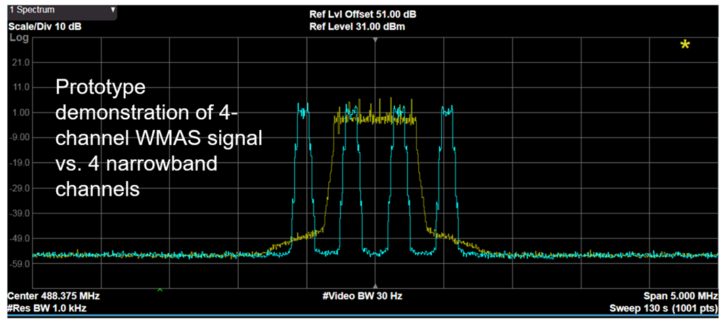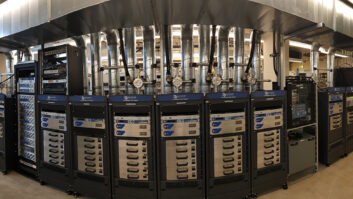
A technology called Wireless Multi-Channel Audio Systems, promoted by companies like Sennheiser and Shure, promises to help meet demand for more wireless mics, especially during large events.
Its supporters say increased demand combined with FCC actions have significantly reduced the spectrum available for wireless, principally in UHF frequencies within the TV bands.
The National Association of Broadcasters and the Society of Broadcast Engineers do not oppose the concept but they want restrictions put on the service if it is approved.
Such systems allow mics to operate using wider bandwidth channels than currently allowed, by digitally combining multiple signals. The technology also uses a more efficient operating protocol, so more mics can operate in the available spectrum. Similar technology has been adopted in Europe under European Telecommunications Standards Institute standards.
The Federal Communications Commission, in a notice of proposed rulemaking, is taking a good look.
The initial proposal
In 2018 Sennheiser asked the commission to formally define WMAS as a new class of wireless mics. It asked that WMAS be allowed to occupy up to a 6 MHz channel bandwidth — the size of an entire TV channel — rather than the 200 kHz channels allocated for low-power auxiliary stations (LPAS) in the TV bands, and it asked that WMAS be permitted to operate in several bands already available for licensed LPAS operations.
By digitally combining signals from multiple devices into a 6 MHz channel, it said, intermodulation issues would be eliminated while permitting denser use of the spectrum and reducing power density across the channel.

Sennheiser differentiates between two groups of devices. Microphones and in-ear monitors require the highest possible audio quality and lowest latency; these devices, according to Sennheiser, currently require a 200 kHz channel. Intercom and IFB systems, on the other hand, can tolerate limited frequency response and dynamic range as well as some distortion and latency. Sennheiser says these devices can operate in a 25 kHz bandwidth. Most events require a mix of both types.
The company noted that the proposed 6 MHz channel could be configured for many combinations, such as 18 high-quality devices; four high-quality devices and 20 intercom channels; or two high-quality devices, 12 mid-quality links and 16 intercom channels.
To assure efficient use of spectrum, Sennheiser originally suggested that WMAS devices be required to operate with a minimum of 12 wireless mics in the 6 MHz channel, but now supports adoption of the standard found in ETSI 300-422.
First reactions
Early responses came from wireless manufacturers Alteros and Shure, as well as Microsoft, and the Aerospace and Flight Test Radio Coordinating Council, which must approve LPAS operations in one of the proposed bands.
All were generally supportive. Shure in particular has been expressing support and calling WMAS “a robust opportunity for boosting spectral efficiency” that could meet demand from broadcasters, music, theater, sports and many other applications.
However, Alteros, Shure and Microsoft all said the minimum number of mics should be higher than the 12 suggested by Sennheiser. Also, Microsoft opposed operations in the unlicensed 6-megahertz portion of the 600 MHz duplex gap, which it views as critical for white space devices.
Alteros argued that the FCC should require a method that allows synchronization across multiple manufacturers’ systems within the single frequency band. Microsoft agreed. “In particular, the ability of microphones from different vendors to plug into a single WMAS at a venue will lead to more efficient use of the limited UHF spectrum. Otherwise, venue operators conceivably might need to request multiple 6 MHz channels,” it said.
Sennheiser opposes that, saying that designing to accommodate the lowest common denominator may underutilize the spectral efficiency benefits of WMAS.
(Note, Alteros was a subsidiary of Audio-Technica, which closed Alteros in 2019 and stopped manufacturing that line of products. Audio-Technica has not filed comments since then. Contacted by Radio World, it declined comment.)
Summary of FCC proposals
Then this spring, the FCC issued its notice of proposed rulemaking. Comments were due in early August.
It asked for comment on allowing WMAS on a licensed basis in most of the bands where Part 74 wireless mics are permitted, including the TV bands, 600 MHz duplex gap and portions of the 900 MHz, 1.4 GHz and 6/7 GHz bands.
Also it proposes to allow WMAS to use a 6-megahertz maximum bandwidth, though the bandwidth of a device could be smaller if necessary.
But as suggested by Shure, the FCC proposed that WMAS devices comply with a spectral efficiency requirement of at least three audio channels per megahertz, which translates to 18 audio channels per 6 megahertz.
Shure believes that “top tier” pro systems currently supporting 14 to 17 channels per 6 MHz could expand to double or more to support 30+ channels. In-ear monitoring using OFDMA technology could triple the channels available in a continuous 2 MHz spectrum band.
(The FCC thought that Sennheiser’s 12 channels per 6 megahertz would not represent an improvement over existing technology, and it said Alteros’ suggestion of 24 channels might not be achievable in some cases.)
Regarding output power, the FCC proposed to allow WMAS to operate at the same maximum levels as other Part 74 LPAS devices, though Shure laid out arguments for higher power levels.
The commission proposed to conform its rules to a recently updated European standard for WMAS.
And though not prompted to do so, it asked whether WMAS should be permitted under Part 15 for unlicensed wireless operations in the TV bands, 600 MHz guard band or 600 MHz duplex gap. It asked about the impact of that on white space devices that share spectrum with unlicensed wireless.
Seeking flexibility
Excited about the rulemaking, Sennheiser came back with suggested tweaks.
It said the proposed minimum of three audio channels per megahertz would be counterproductive; it now recommends that the commission adopt an ETSI standard which states that WMAS must have a mode that supports (i.e., have the ability for) three audio channels per MHz, rather than a mandate for operation with a minimum number of mics.
“Adopting the ETSI standard would allow the commission to ensure that its spectrum efficiency goals are achieved, while simultaneously futureproofing its rules by granting users the flexibility to operate the system in other modes as required by new applications or workflows during operation.”
Sennheiser now thinks that in most cases, WMAS will be operated using 24 or even more channels within a 6 MHz TV channel, where today eight conventional narrowband wireless mics generally fit into that channel. And it said WMAS could become even more efficient thanks to immersive audio and object-oriented audio mixing. So it thinks that codifying a minimum number of channels may be counterproductive.
Regarding Part 15, Sennheiser noted that WMAS is targeted for “challenging professional applications faced by licensed engineers,” but said unlicensed operation could benefit all spectrum users. Shure too now says the FCC should authorize both.
And Sennheiser and Shure both emphasized that WMAS is not a solution to the crunch created by the FCC’s reallocations in the 600 and 700 MHz bands. Both say the FCC should not have terminated another proposal that would have set aside a vacant low-band UHF channel in each market for wireless mics; they asked the FCC to “reverse course” on that.
Broadcasters are cautious
Other stakeholders weighed in.
The National Association of Broadcasters supports WMAS on a “secondary basis” with “prudent restrictions,” given that WMAS “has a greater potential for interference” and is not compatible with legacy narrowband wireless deployments.
It said WMAS occupies more spectrum than traditional systems. “If there is only a single 6 MHz TV channel available for use at a breaking news event, one news crew using a WMAS system could occupy the entire channel and prevent coverage by other news organizations.”
So NAB thinks the FCC should limit WMAS to situations where a large number of channels are needed and will be under control of one entity, such as big concerts and sporting events; and it suggested that a threshold of 10 channels in use by a single entity. It also said the FCC should only authorize base stations that prevent transmission when fewer than 10 paired audio devices are detected.
NAB thinks the FCC should require minimum efficiency of six audio channels per megahertz, equivalent to 36 in 6 MHz, because a minimum of three would be no meaningful improvement. It asked the commission to restrict WMAS to Part 74 licensees, and to limit the systems to 6 MHz bandwidth. And it agreed with an FCC proposal to limit power to 250 mW EIRP in the UHF TV bands, regardless of the bandwidth of the WMAS operation.
Meanwhile the Society of Broadcast Engineers said the use of WMAS should be subject to coordination with SBE local frequency coordinators, and said these systems should be operated only on a non-interference basis to incumbent wireless technologies.
The society, like the mic manufacturers, said the FCC should not view WMAS as a sufficient response to the “critical shortage” in spectrum for wireless.
Another question asked by the FCC is about the 6875–6900 MHz and the 7100–7125 MHz bands. The commission recently made the whole 6 GHz band available for unlicensed use to encourage next-gen Wi-Fi and the Internet of Things. So it asked whether WMAS should be authorized there and whether Part 74 wireless mics should even be permitted in those bands any longer.
Cisco Systems, Facebook, Microsoft and the Wi-Fi Alliance all told the FCC it should not permit WMAS in those bands, and some said the FCC should not allow Part 74 operations at all. But Shure disagreed strongly with any suggestion that efficiency gains from WMAS opens the door to eliminating wireless access to the “6/7 GHz” bands, saying WMAS should not be viewed as a “cure all.”
Reply comments in the NPRM are due Aug. 30.
Implications
If WMAS is approved, what next?
Joe Ciaudelli, director, spectrum & innovation at Sennheiser, told Radio World, “We plan to conduct extensive field demonstrations with industry veterans. This is not only a revolutionary technology. It also provides a highly flexible alternative workflow. Even though it is simple to use, we want ample opportunity to hear the feedback from the field. Systems will be is use well before the official public launch.”
Ahren Hartman, VP of quality at Shure, urged interested parties to be vocal. And he hopes the FCC will allow unlicensed operation. “If unlicensed microphone users are not authorized to operate WMAS devices, that severely limits the available market for these products, which could jeopardize the technology commercialization,” he said.
“If the FCC grants WMAS access to all wireless microphone users, licensed and unlicensed, and aligns the technical rules with the European ETSI version, the groundwork will be laid for manufacturers to produce WMAS products as soon as technically possible.”
Both are enthusiastic about how WMAS will help engineers and frequency coordinators at very large events.
“The impact will be radical,” Ciaudelli said. “First and foremost, the engineer can pack far more wireless links within a 6 MHz TV channel, using a single RF carrier — typically four or five times more, depending on how the operator sets parameters such as latency, link robustness and audio quality. It’s also much easier to configure, plan and operate large multi-channel systems.
“Plus, the operator can essentially reuse spectrum resources,” he continued. “You can set the mics that are being broadcast live at a given moment to have the majority of the resources, while the mics that will be used in the next segment of the event can be turned on and tested using minimal spectrum resources. When it’s time for the next segment to go live, the associated mics will take over the majority of the resources.
“It’s different than the conventional approach that would use different channels for each set of mics. WMAS really shines for any multi-act mega-event like the Super Bowl, as well as for major music festivals or award shows.”
Hartman said the impact will depend on the final rules. “If the FCC adopts the technical parameters proposed by Shure, WMAS will have the ability to dramatically simplify frequency coordination for any size events, including large ones like the Super Bowl. Since WMAS is more spectrally efficient than conventional narrowband transmission, it allows users to pack more microphone/IEM channels in the same spectrum, making even planning easier in congested cities,” Hartman said.
“WMAS also manages intermodulation distortion (IMD) differently than narrowband transmission, essentially removing IMD from the planning, and therefore, simplifying frequency coordination. And finally, since WMAS can be designed to be bidirectional, both microphones and IEM channels can be packed into the same WMAS system, which makes spectrum planning simpler.”
A question that surfaced early is whether WMAS may cause interference to services in adjacent channels.
“No, in fact, it’s the opposite,” Ciaudelli said. “WMAS transmits multiple wireless audio links on a single carrier at the same power output as one conventional narrowband wireless microphone. Because WMAS spreads its power over an entire 6 MHz TV channel instead of 200 kHz like a narrowband wireless microphone, the power spectral density is significantly lower, reducing risk to adjacent services.”












